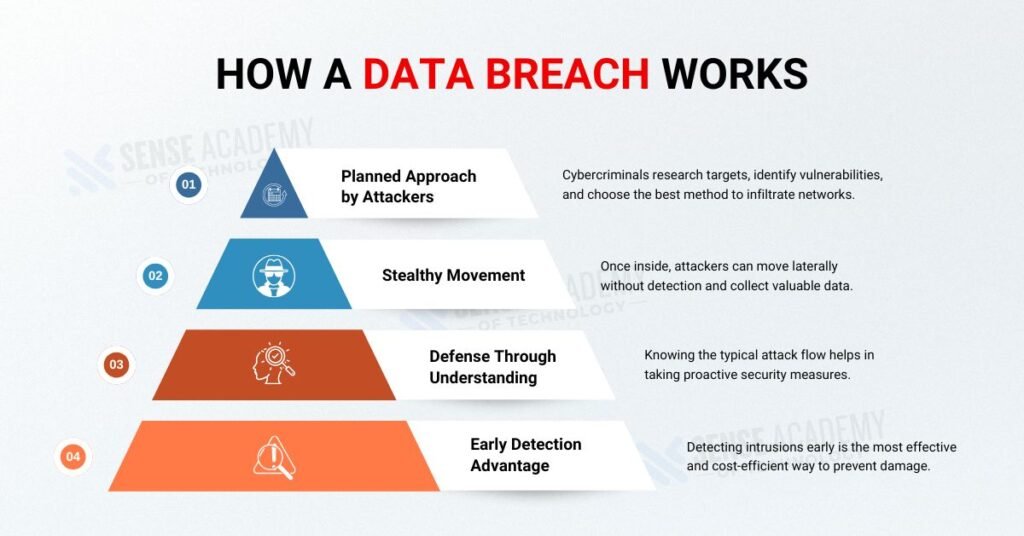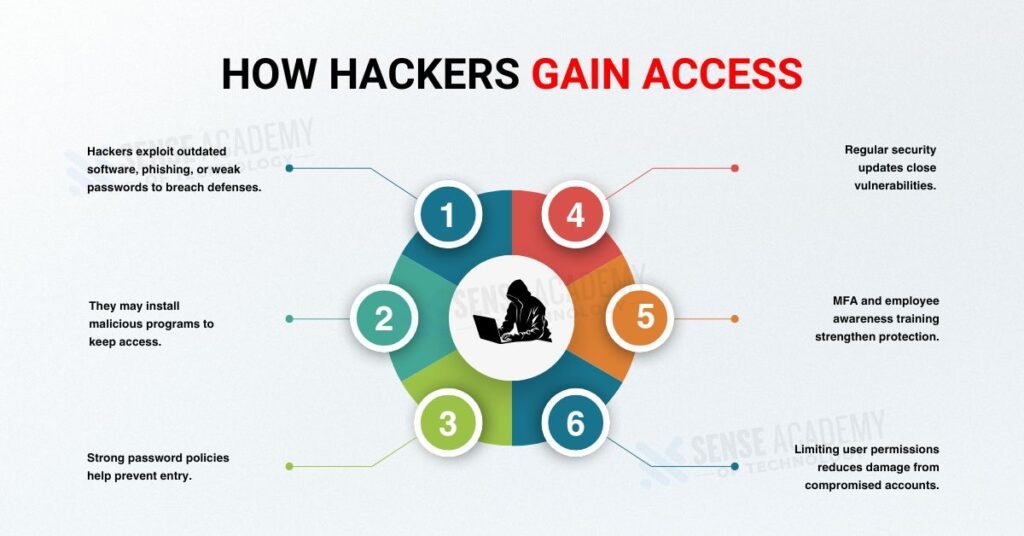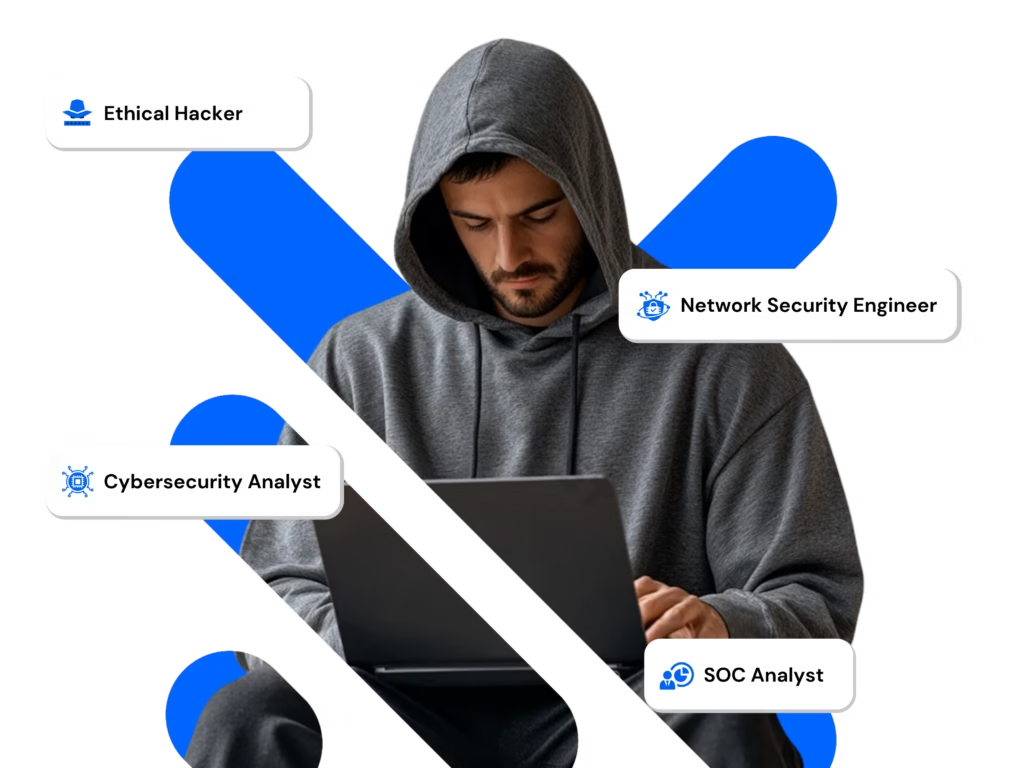A data breach is rarely a single, sudden incident; rather, it is the result of deliberate planning, execution, and exploitation of vulnerabilities by hackers to obtain private data. Attackers frequently start by quietly examining their target, figuring out any weak spots, and figuring out the best approach to get inside. They can travel undetected, collect important data, and get ready for theft or damage once they have gained access to the system. Knowing these phases is crucial because it enables organizations to identify and stop assaults before serious damage is done. Every stage presents an opportunity to stop an attacker with the correct awareness and protection. The most efficient and economical method of preventing a breach from turning into a crisis is still early discovery.
Table of Contents
How a Data Breach Works

The method by which cybercriminals enter and exploit networks is organized, and a data breach is not a single case. Before attacking, attackers research their target, look for flaws, and determine the best way to get inside. Once inside, they can navigate through networks without being seen and gather important data. Strong defense tactics require an understanding of this flow. Knowing how the attack is likely to go allows you to take action before actual harm is done. There is a chance to find and stop the intruder at every level. The best and most economical defense is early awareness.
Spotting Early Warning Signs
Detection, or hidden investigation to find security flaws, is frequently the first step in a data breach. Hackers can obtain compromised credentials from the dark web, search for open ports, or scan networks. Since there hasn’t been any actual intrusion yet, this stage is simpler to identify than subsequent ones. Here, intrusion detection systems, network monitoring, and less public exposure can all be beneficial. It’s also critical to teach staff members to exercise caution while sharing information online. The sooner you identify questionable probing, the more control you keep. By taking action immediately, a small threat can be stopped from becoming a full-scale assault.
How Hacker Gain Access

When hackers manage to get past your defenses, a data breach occurs. They frequently do this by taking advantage of obsolete software, phishing emails, or weak passwords. To keep access after they’re inside, they might install harmful programs. Strong password regulations, frequent security updates, and efficient employee awareness training are necessary to stop this. An effective additional security measure is multifactor authentication. Restricting user permissions guarantees that the harm will be modest even in the event that one account is compromised. Proactively addressing entry points makes them the easiest to secure. By stopping intruders now, a more expensive and involved cleanup is avoided later.
Preventing Lateral Movement
A data breach can escalate quickly when hackers move laterally inside a system, searching for sensitive files and high-value targets. They may take control of additional accounts and disable security notifications to avoid detection. This is where network segmentation and strict access controls become essential. Continuous monitoring helps detect unusual activity, such as abnormal login patterns. Incident response teams should act immediately to isolate affected systems. The goal is to contain the attacker’s movement before they reach critical assets. Quick action here can mean the difference between a small incident and a company-wide disaster.
Blocking Data Theft
When hackers start transmitting data outside of your network, or exfiltrating it, a data breach becomes even more harmful. They might encrypt it for cash or pass it off as regular traffic. Businesses should employ data loss prevention measures, encryption, and stringent outgoing traffic monitoring. This renders stolen information worthless to criminals, even if they are successful in obtaining it. Mid-process theft can be prevented using real-time notifications for anomalous transfers. At this point, detection accuracy and speed are crucial. It becomes very difficult or impossible to recover data after it is out of your hands.
Acting Fast During an Attack
To prevent additional harm, a data breach in progress must be contained right away. This includes restricting the attacker’s access points, deactivating compromised accounts, and isolating impacted systems. The next step is eradication, which includes deleting harmful files, fixing exploited flaws, and closing vulnerabilities. Teams are certain to know exactly what to do without doubt when they have an incident response plan in place. Everyone is prepared for a serious attack through regular training. At this point, your greatest advantage is speed. The attacker can do less before you stop them if you move quickly.
Back to Regular Operations
During a data breach recovery phase, the primary objectives are system restoration, data integrity verification, and system restart. At this point, a thorough investigation of the process underlying the intrusion is also necessary. The lessons learned here should lead to updated policies and stronger defenses. Communication with the parties affected is crucial for compliance and trust. Backup plans and disaster recovery strategies speed up recovery. Post-breach studies often uncover overlooked security vulnerabilities. Think of recovery not just as a way to fix things but as an opportunity to build resilience.
Staying Safe in the Future
A plan for preventing data breaches depends on ongoing attention to detail and development. Frequent vulnerability scans, penetration tests, and security audits assist in locating flaws before attackers do. It is imperative that systems and software be kept up-to-date. Employee education guarantees that everyone is able to recognize suspicious activity and phishing attempts. Security shouldn’t be an afterthought; it should be a part of the everyday process. Future occurrences are less likely when proactive steps are taken. An organization that continuously improves its defenses, learns, and adapts is the safest.
FAQ’s
Which factor contributes to data breaches the most frequently?
The most common entrance point for attackers is still phishing attempts. Passwords that are weak or stolen also make systems easily accessible. Vulnerabilities and outdated software are widely exploited. A significant factor in many breaches is human mistake. Frequent security updates and training aid in lowering these threats.
What is the typical time frame for identifying a data breach?
Organizations typically take over 200 days to discover a breach because of this extended window, attackers can get deeper into systems without being noticed. Intrusion detection systems (IDS) and SIEM solutions are examples of early detection methods that help reduce this time. Anomaly detection and ongoing network monitoring are also essential. Damage and recovery expenses are significantly reduced by cutting down on detection time.
When a business discovers a data breach, what should it do right away?
To prevent more illegal access, first contain the breach, then disable compromised accounts as soon as possible and isolate impacted systems as needed, and notify stakeholders, internal teams, and regulators. After that, remove harmful files and fix vulnerabilities to start the eradication process and to make future security measures stronger. Keep a record of the incident.
Conclusion
Organizations may identify risks earlier, react more quickly, and reduce damage by having a better understanding of the entire data breach process, from reconnaissance to recovery. Businesses can drastically lower their risk by combining effective preventative measures, quick incident response, and ongoing improvement. The most resilient companies are those that view cybersecurity as an essential component of their everyday operations; it is not a one-time endeavor but rather a continuous commitment.





